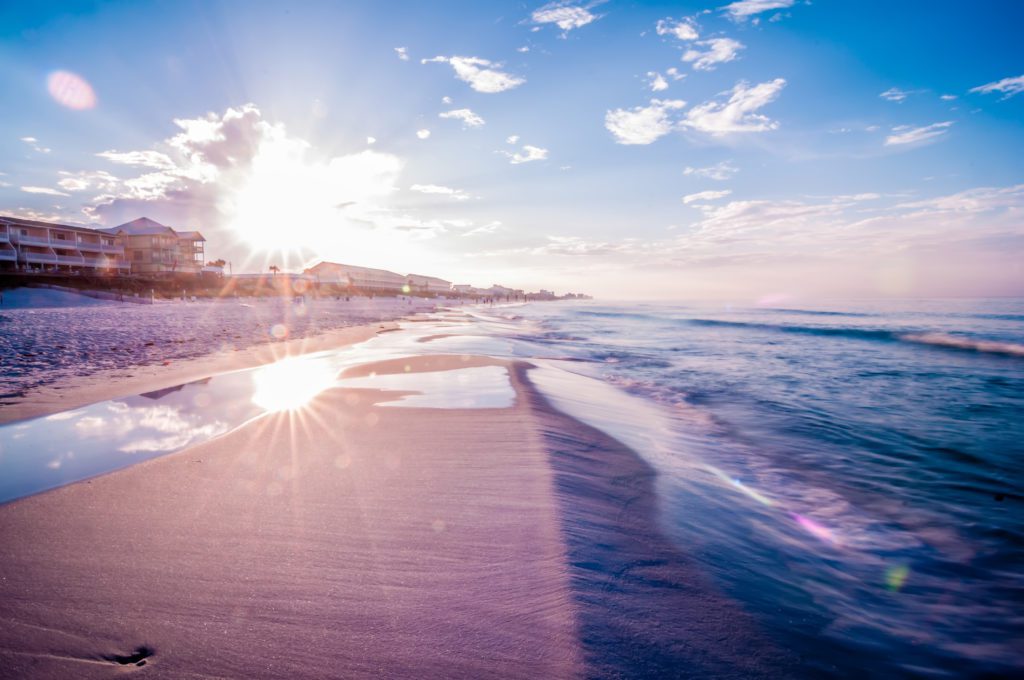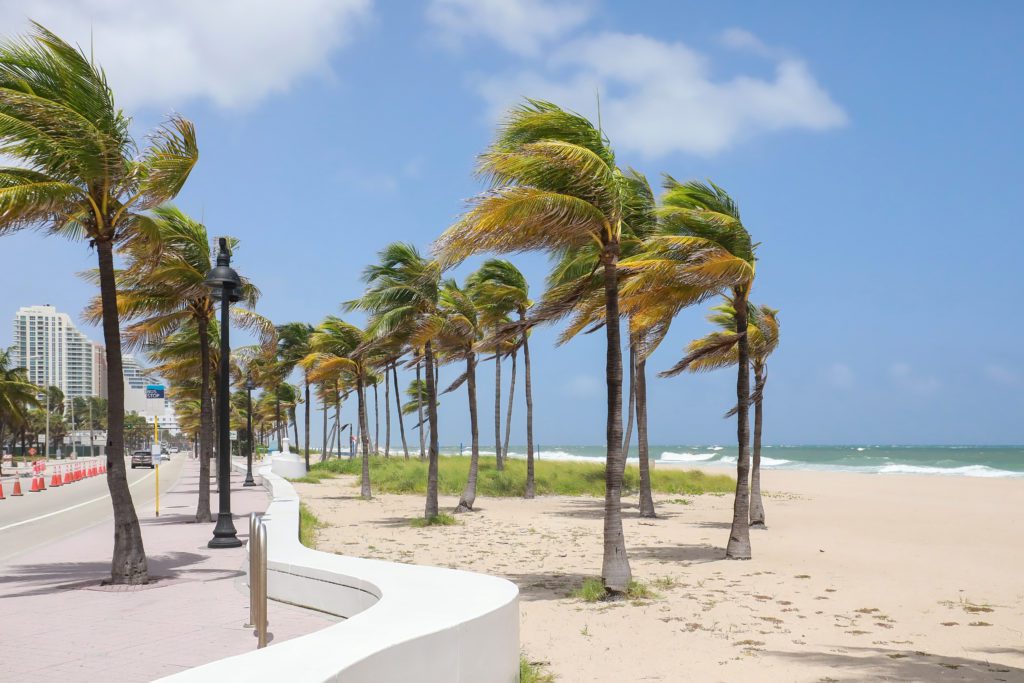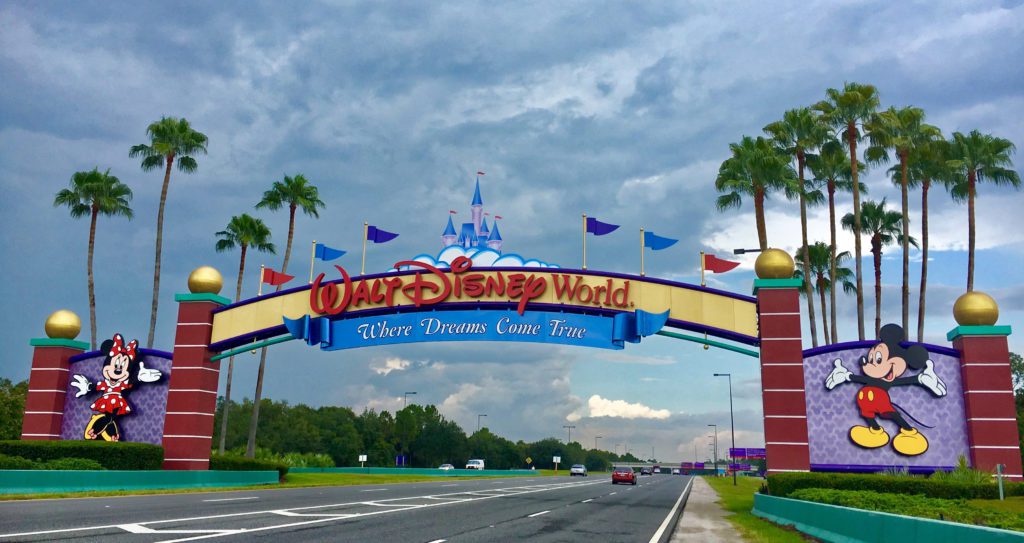Did you know that the number one industry in Florida is tourism?
From its breathtaking beaches to its thrilling theme parks and water parks, there’s so much to do from the Panhandle all the way down to Key West. A significant part of the reason is the climate.
Even though it often feels tropical, Florida is not immune to changes in weather depending on the season. The Sunshine State certainly experiences variation in temperatures and other climate conditions depending on the time of year.
Let’s take a look at average weather patterns each month out of the year. We’ll also try to highlight differences in the distinct parts of the state so that you can choose the perfect month for your next getaway.
- What’s the Weather Like in Florida in January?
- What’s the Weather Like in Florida in February?
- What’s the Weather Like in Florida in March?
- What’s the Weather Like in Florida in April?
- What’s the Weather Like in Florida in May?
- What’s the Weather Like in Florida in June?
- What’s the Weather Like in Florida in July?
- What’s the Weather Like in Florida in August?
- What’s the Weather Like in Florida in September?
- What’s the Weather Like in Florida in October?
- What’s the Weather Like in Florida in November?
- What’s the Weather Like in Florida in December?
- When is the Rainy Season in Florida?
- When is Hurricane Season in Florida?
- Is There Any Month When You Should Not Visit Florida?
- When Is the Quietest Time to Visit Walt Disney World in Florida?
What’s the Weather Like in Florida in January?
January is typically the coolest month of the whole year in Florida. Average low temperatures fall to the high 40s and low 50s, particularly in the Panhandle and other more northern parts of the state. That being said, it often gets up into the mid-70s throughout the day in Miami, the Keys, and the other more southern locales.
Rainfall is relatively low in January, especially compared to other months. Florida is always humid, but less so during cooler weather.
Because of these more mild temperatures and low rainfall, January is a great time to visit Florida’s theme parks, especially if you don’t like being outside in the heat and humidity. Major resorts also tend to heat their pools, so you still have the opportunity to enjoy some aquatic adventures.
What’s the Weather Like in Florida in February?
Things start to pick up in February in Florida, temperatures and otherwise. Early morning and evening temperatures can be quite cool further north, but the days get longer. In addition, there is still very low rainfall throughout the state.
Lots of northeastern families make a southern sojourn to the Sunshine State over school winter breaks in February. Average temperatures are slightly higher than in January. Most parts of the state reach 70 degrees during the day, with lows in the high 40s and low 50s. Ample sunshine and low humidity make it very comfortable on the beaches.
What’s the Weather Like in Florida in March?
March is a hectic month in Florida, as spring breakers from around the country descend on its beaches and other attractions. Lucky for them, they’re likely to enjoy warmer temperatures and little rain.
Average temperatures climb to highs in the high 70s and 80s, while lows are also warmer, high 50s and low 60s. While March sees more rain than January or February throughout the state, the average rainfall is still under four inches in central and southern Florida.
The higher temperatures and low rain, in addition to spring break schedules throughout the country, mean that March is going to be much busier for tourists. Walt Disney World begins its slate of annual festivals with the Epcot Flower and Garden Festival as well, so be sure to plan accordingly.
What’s the Weather Like in Florida in April?
From March, the weather trends carry into April, with temperatures continuing to climb into the 80s most days in most parts of the state. Rainfall is still low, even slightly lower than in March in most parts of the state, especially the Panhandle.
While temperatures climb, tourism tails off as the month goes on. By the middle of the month, spring break is over, and Easter has passed (in most years). In addition, many “snowbirds” return north to their spring and summer homes. Fewer people means more space on the beaches, in restaurants, and at the theme parks and other attractions.
What’s the Weather Like in Florida in May?
As May progresses, it begins to feel more and more like summer in Florida. Average high temperatures range in the mid-high 80s, but high temperatures rarely exceed 95 degrees. In addition, it can be quite humid, with humidity over 80%.
Overnight and early morning temperatures tend to be in the 60s. Rainfall also increases in the south and slightly decreases in north Florida. Crowds also tend to be lower since many parents hesitate to take their kids out of school at the end of the year.
The summer season officially kicks off over Memorial Day weekend, the last weekend in May, and crowds at nearly all the state’s popular attractions grow.
What’s the Weather Like in Florida in June?
Once June hits, summer in Florida is in full swing, and it really starts to feel like it. Humidity can reach over 90%, especially in central Florida. Most days, temperatures reach the high 80s or low 90s, meaning that visitors must give special care to proper hydration and sun protection.
June is also Florida’s wettest month overall, particularly in central and southern Florida. However, this is a good thing. Most of the heavy rains fall during big afternoon storms, which quickly give way to sunny skies. What’s more, those storms tend to cool things off, so if you’re at a theme park, don’t leave! Seek shelter for a little while and wait it out.
Also worth noting is that hurricane season kicks off in June, though they’re rarer this early on.
June is a beautiful season to visit Florida, with the summer solstice at the end of the month, especially its beaches. Just be prepared for crowds.
What’s the Weather Like in Florida in July?
We can sum up the weather in July in one word: hot! July is the hottest month of the year in Florida, with temperatures usually reaching into the low 90s. What’s more, the humidity soars to around 90% in most parts of the state.
Like June, though, afternoon storms often cool things off for the evening. Many beach visitors like to hit the waves early, beat the storms back to their accommodations, and then venture out for dinner or nightlife. Tourism is high in July, so make all reservations well in advance to get better prices and availability.
What’s the Weather Like in Florida in August?
August is slightly cooler than July, and with humidity still in the 90% range, the drop is barely perceptible. Rainfall also increases throughout the month. Sometimes, it’s from those afternoon storms, but August is also the start of peak hurricane season. If you’re planning an August Florida vacation, you may want to purchase insurance, just in case.
There is also a rather stark difference between the beginning and end of the month. While temperatures and other weather conditions remain hot and sticky, crowds fall steadily as more and more kids (including the locals) head back to their classrooms.
What’s the Weather Like in Florida in September?
August, September, and October compose the peak hurricane season in Florida, but if you get lucky and avoid them, September can be quite a lovely time of year to visit. Temperatures fall precipitously throughout the month, back into the 80s most days for highs by the end of the month.
You can expect those afternoon thunderstorms to keep rolling on most days, especially in the earlier weeks. However, crowds are much smaller since summer officially ends on Labor Day, and everyone is back in school.

What’s the Weather Like in Florida in October?
The trends that began in September continue into October, and as the month marches on, hurricanes become less and less likely. Average high temperatures are in the mid-high 70s, with lows in the 60s, particularly in the early morning and late evening hours.
The humidity still tends to be high in October, around 85%-90% at its peak most days. However, the cooler temperatures mean that it doesn’t feel as oppressive. The rain also starts to decline in October as long as you avoid a hurricane.
What’s the Weather Like in Florida in November?
November feels markedly different from the past several months. Temperatures continue to fall, with highs in the 70s-80s and lows in the 60s, which also helps relieve the intensity of the humidity. Rain also falls off precipitously, with an average rainfall of around 2 inches per month.
Still, the Sunshine State lives up to its name, with clear skies and ample rays. Crowds increase steadily throughout the month until Thanksgiving, when the Christmas season officially begins, especially at the theme parks. Early November is a favorite time of year for many adults-only families and visitors.
What’s the Weather Like in Florida in December?
While January is Florida’s coolest month, December isn’t far behind. Temperatures continue to fall, with highs in the 70s most days and lows in the 50s and 60s. Humidity also falls to peak percentages in the 80s most days.
Rain becomes quite rare; in most parts of the state, it is under three inches of monthly precipitation. The chance of hurricanes is also very slim.
If you don’t like the heat, December is a great time to visit. Crowds typically slow down after Thanksgiving but will rise steadily as Christmas approaches. The week between Christmas and New Year’s Eve tends to be one of the busiest.
When is the Rainy Season in Florida?
The rainy season in Florida begins in mid-May and continues through October. The average rainfall throughout the state is around five or more inches during these months, compared to less than three during the rest of the year.
The average number of rainy days also increases. While the fall and winter months see about seven days of rain, the summer sees 14 or more each month in most of the state.
That being said, don’t write off a visit during these months. Much of that rain falls during passing afternoon storms, giving way to sunny skies and cooler temperatures in the late afternoon and evening.
When is Hurricane Season in Florida?
Hurricane season officially begins on June 1 and extends through October, though the peak months are August, September, and October (especially early October). Hurricanes have become more frequent in the later months of the season over the past decade or so.
Keep in mind that a hurricane doesn’t need to make landfall in Florida to impact its weather. The effects of a hurricane hundreds of miles away in the Caribbean, Gulf of Mexico, or the Atlantic Ocean can be felt throughout the state, usually bringing heavy rain and wind.
If you’re traveling during hurricane season, it isn’t a bad idea to purchase insurance for your trip, just in case.

Is There Any Month When You Should Not Visit Florida?
The short answer is no, of course not! Florida is beautiful throughout the entire year; there’s never a wrong time to visit.
The longer answer is that it depends on what you want out of your experience and your personal preferences. If heat and humidity drag you down, then summer may not be the best time for you. But if you’re looking to spend all day on the beach, then the hotter, the better.
The bottom line is that you can’t control the weather. Make an informed decision about what time of the year is most likely to be enjoyable to you, and be prepared for deviations from the norm. Be sure to plan indoor and outdoor activities, just in case.

When Is the Quietest Time to Visit Walt Disney World in Florida?
The Walt Disney World Resort in Florida is one of the busiest tourist destinations on the planet, so there is no real off-season, but there are “quieter” periods. In fact, during each month, attendance levels can vary dramatically for many reasons.
Generally speaking, crowds are lowest from mid-January (once you get past the New Year’s crowd) until mid-February, until winter breakers descend after President’s Day. Once the kids go back to school in September, crowds tend to stay moderate through Thanksgiving. However, weekends are still busy, and the Epcot Food and Wine Festival also draws crowds.
If you want to minimize crowds, try to avoid holidays and school breaks. Even long weekends over minor holidays like Martin Luther King Day are busier since many Florida residents and other locals make the drive.
More about our TFVG Author
A seasoned traveller, Dad, and avid sports tourist, James foundered The Family Vacation Guide to share his expert vacation experiences- especially when it comes to being a travelling family man.
Featured in Travel articles such as Travel + Leisure, TripSavvy and SFGate, you know you're reading some of the best vacation tips online.





